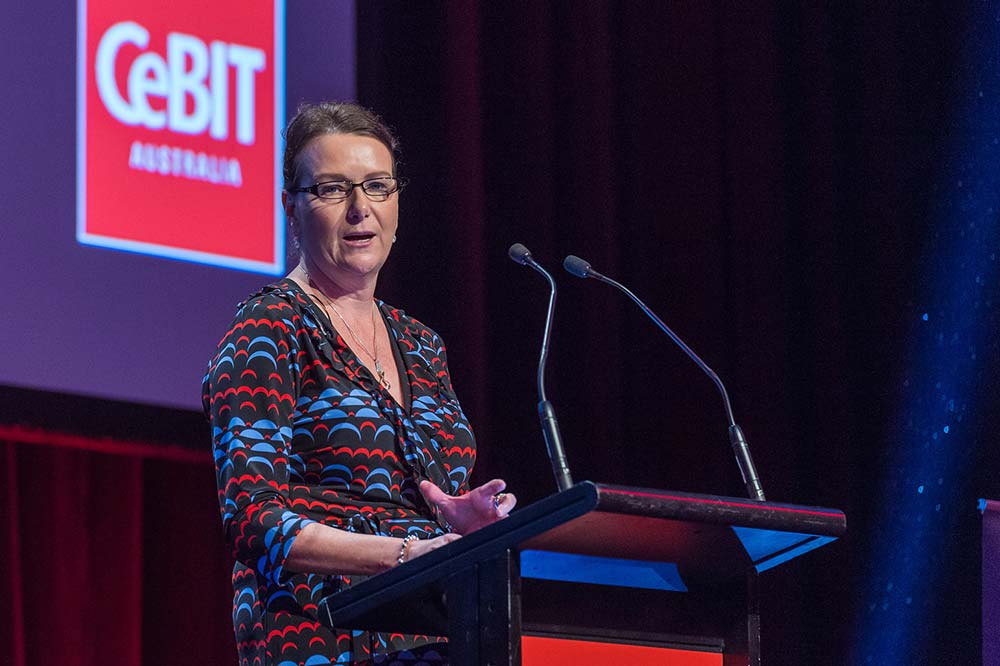
Assistant Secretary Data Policy in the Department of Communications, Department of the Prime Minister and Cabinet, Helen Owens. Image: CeBIT Australia.
In a presentation to the eGovernment forum at CeBIT Australia 2016 recently, Helen Owens, Assistant Secretary Data Policy in the Department of Communications, Department of the Prime Minister and Cabinet, called for redoubled effort to improve digital service provision to citizens.
In her paper, “The future of government service delivery” Ms Owens said that although the government had made considerable progress as part of the Digital Transformation Agenda announced in May 2015 there was “room to improve” the provision of government services online.
Ms Owens works closely with the Digital Transformation Office (DTO), a portfolio agency of the Department of the Prime Minister and Cabinet (PMC).
“While some government agencies have made good progress in digitising services that could not only be accessed over the counter or phone, the level of progress from one agency to the next is inconsistent,” she said.
There are considerable cost savings to be made from the process of digital transformation of services to citizens. Ms Owens outlined the cost breakdowns for various modes of service provision which drove home the need to provide better online experiences for citizens to deter them from going back to “face-to-face counter” experience.
“The government sector in Australia is a third of the economy so it makes sense to deliver services as efficiently and as cost effectively as possible. By making greater use of the internet, governments will not only improve their own productivity, they’ll also save users’ time when dealing with government.
“Australians have become used to easy and seamless interactions when they’re doing their online banking or shopping, across a range of devices; and they’ve come to expect the same when dealing with government.
“A survey conducted by Boston Consulting Group in 2014 showed that 55 per cent of users faced a problem while using online government services; with navigation and design the most commonly cited issues. In fact, 20 per cent of respondents stated that the overall process took too long or was too difficult.
“Similarly, a survey of Australian taxpayers conducted by Accenture in the same year showed that half of the taxpayers who currently use government digital services find it hard to self‐service from end‐to‐end.
Communication through the different channels is not seamless, and this too negatively affects users’ digital experience. In addition to transforming services to better meet user needs, there are potentially significant cost savings to government.
“According to Deloitte Access, each face-to-face transaction is conservatively estimated at $16.90, with postal transactions costing $12.79 and telephone calls costing $6.60. In contrast, digital transactions cost 40 cents, and this is likely to fall over time as technology improves and scale advantages are harnessed.
“That same report estimated that of the 811 million transactions with government agencies every year, around 40 per cent are still completed using non‐digital channels. If over the next 10 years this was reduced to 20 per cent, the change would deliver around $17.9 billion in savings to government and a further $8.7 billion in savings for Australians through time, convenience and out‐of‐pocket savings,” Ms Owens said.
Key to the improvement of digital service delivery is an “agile methodology” that will enable progress to be iterative, to “meet the needs of the user and so that solutions are not locked in prematurely before problems or opportunities are identified”.
The government will also deliver exemplar projects via two delivery hubs in Canberra and Sydney partnering with federal departments and state and territory governments.
Examples of these showcase projects included working with the Queensland Government to simplify the process for seniors to access concessions and entitlements; as well as working with the ACT Government to deliver an easier and better way for people to manage outpatient and community-based health services across the ACT.
Ms Owens also outlined the importance of a whole of government approach to reduce costly duplication.
To reduce “reinvention of the wheel”, the government will strive to seek out common features that will form the “building blocks” or common platforms. Once commonalities are found they can be duplicated “across government … making services more efficient and quicker to build”.
Examples of these include:
- GOV.AU and govCMS – will consolidate more than 1000 different Australian Government websites to provide more consistent services and information.
- The Digital Marketplace – will make it easier for digital suppliers to connect with government.
- Digital identity – better identity proofing and authentication.
- Performance Dashboard – information about the performance of government on a new dashboard.
- cloud.gov.au – infrastructure, monitoring, and delivery tools for teams in government to release and operate user‐facing web applications easier.
Finally, Ms Owens said the government’s goal is to provide services that are “simpler, faster and easier to use”. No doubt everyone in the room will watch with interest as the programs evolve and may well take up the invitation to provide feedback.





